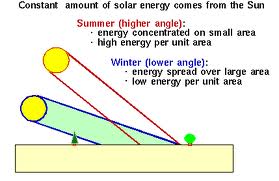Our long, dry, mild spell continues unabated. It might well stretch back to Thanksgiving! Our days have been mild, and this week the forecast is for even warmer days! And yet – cold nights! Why? Let’s look at some basics…
First, of course, it’s winter! So it’s supposed to be cold! Winter means two things: (1) fewer hours of sunlight every day. This matters because the sun is our ultimate source of heat. So – no heating at night! And (2) the sun is lower in the sky. You can see this best around noon, when the sun is as high in the sky as it gets all day. Take a look at where the sun is in the sky around noon – you should find yourself looking towards the south, and seeing that the sun is not directly overhead, but is a little lower in the sky. Six months from now, the noon sun will be much higher in the sky. Why does this matter? When the sun is lower in the sky, it’s “heating rays” have to travel through more atmosphere to get here, as this diagram shows:
As a result, the sun’s heating in winter (as it is now, supposedly!) is less effective than in summer. Because of these two factors (and some others), our days are cooler in winter. But what about our nights?
At night after the sun has set, there is no more heating coming in from the sun and we begin to cool. This cooling is accomplished via the physical process know as radiation. Warm air down near the ground radiates energy upward, and as a result that air cools. Worst-case scenario is that ALL this energy radiates upward out into space. If that were to happen, the atmosphere would be much colder than it actually is. But instead, molecules within the atmosphere actually absorb that outgoing radiation and thus prevent its loss. In this way, the atmosphere serves as a “blanket”, preventing heat loss. The physics of this was developed starting in the early 1800’s – well over a century ago! Along the way, the effect came to be known as the Greenhouse Effect – read the history section here! Scientists have calculated the impact of the greenhouse effect – it warms us by roughly 60 deg F! In other words, without the greenhouse effect, the air would be about 60 deg colder than now. It would be more like living on Mars!
So what are these mysterious molecules within the atmosphere responsible for the greenhouse effect – and how does this explain our chilly nights? The most famous greenhouse gas is carbon dioxide, the object of much attention. But the most effective greenhouse gas is – water vapor! On any given night, the presence of water vapor in the air above us prevents heat loss – keeping us warm. Well, maybe not “warm”, but definitely warmer than we otherwise would be. On the other hand, on a night when the air is very dry (low water vapor content, low relative humidity), the greenhouse effect is much less efficient, allowing overnight temperatures to drop. If you’ve ever been out in the desert, you know that it can be very hot during the day (over 100 deg F, say), and amazingly cold at night (50 deg F or lower)! The desert is a place where it hardly ever rains, and there is usually very little moisture in the air. So at night? Rapid cooling! The opposite is true in humid locations: overnight temperatures don’t drop anywhere near as much.
This week (Jan 13-17, 2014) in San Jose, the forecast calls for offshore winds, meaning winds flowing from east to west. This leads to drying as air flows down from the Sierras. The dry air means we can forecast two things: (1) chilly overnight lows, as explained above; and (2) high fire danger – not good in January.
